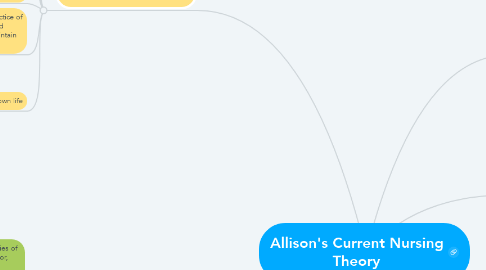
1. Orem's Self-Help Theory
1.1. The nurse must evaluate the patient's abilities and level of self-care
1.2. The nurse must teach and encourage the patient to take responsibility for their health and provide self-care.
1.3. Patient must be self-motivated to provide care for themselves.
1.4. If patient is unable to provide self-care, must be willing to accept help.
1.5. Self-Care deficit. When is a nurse needed?
1.6. Self-care is the performance or practice of activities that individuals initiate and perform on their own behalf to maintain life, health, and well-being.
1.7. How this theory has applied in my own life
1.7.1. Depression
1.7.2. Anxiety
1.7.3. Learning how to live through our own experiences and apply this to Nursing Practice.
2. Swanson's Caring Theory
2.1. Maintains there are five main cateogies of caring: Knowing, being with, doing for, enabling, and maintaining belief. MAINTAING BELIEF ALLOWS THE NURSE TO BELIEVE IN THE PATIENT AND THE PATIENT TO BELIEVE IN THEMSELVES
2.1.1. Knowing helps the nurse to understand the patient' situation.
2.1.2. Being with, allows the nurse and patient to develop a close and trustful bond.
2.1.3. Doing for, allows the nurse to physically care for the patient and encourage the patient that his/her life matters.
2.1.4. Enabling, allows the patient to experience self-healing.
2.1.5. Maintaining belief, allows the nurse to believe in the patient's ability to heal and for the patient to in-turn believe in themselves.
2.1.6. I have been able to use the five categories of caring to help patients heal.
2.2. Helps nurses to deliver care that promotes dignity, respect, and empowerment.
2.3. Improves patient satisfaction
2.4. The more patients feel cared for by the nurses/providers, the more apt the patient is to be compliant and caring about themselves TEACHING THE PATIENT THEY HAVE WORKTH AND VALUE AND THEY START TO SEE THEIR OWN VALUE.
3. Chaos Theory
3.1. the idea that even a small difference or change can lead to dramatic, divergent paths. EXAMPLE OF ICU PATIENT THAT NEEDED ALLERGIC REACTION AND EMERGENCY TRACHEOTOMY
3.1.1. I try to avoid big changes at one time for a patient and try to be understanding that small steps can lead to positive change
3.1.2. I try to constantly be aware of small changes in patient's health or behavior and always notify the attending physician
3.2. Bifurcation is the idea that a sudden change or transition will lead to a period of doubleing, quadrupling and so forth, for the onset of chaos.
3.2.1. I try to be aware of the changes I make in a patient's health are careful, yet necessary. I do not make big changes at one time, unless absolutely necessary.
3.3. Chaos may cause uncertainty for the patient
3.3.1. Important to explain all changes to patient-both big and small
4. Benner's Model of Skill Acquisition in Learning
4.1. Outlines five stages of skill: novice, advanced beginner, competent, proficient, and expert.
4.1.1. I believe it is important to aknowledge our positive attributes and where we may be lacking in our patient care. By aknowlegding our level of skill, we can seek to improve our level of skill.
4.2. Benner identifies seven main domains of nursing practice
4.2.1. Seven domains are: helping role, teaching role, diagnostic client functioning, effective management of rapidly changing situations, ensuring quality of health care practices, organizational and work-role competencies, and monitoring therapeutic interventions and regimens.
4.2.1.1. Personally, I would like to improve in diagnostic client functioning and effective management of rapidly changing situations.
4.2.1.2. I believe I have a good practice with the helping and teaching role with patients.
5. Family
5.1. Parents
5.1.1. Mom was a teacher, taught me how to care for others and provide care for my sister.
5.1.2. Dad was always doing things for others
5.2. Twin Sister, Brandie
5.2.1. Her passing in 2010 has intrigued my interest in Palliative Care, N.P.
5.2.2. Growing up I helped take care of her, which helped to develop my compassion in caring for others
5.3. Nieces and Nephews
5.3.1. Enjoy teaching them about healthcare and how to better take care of their body (emotionally, physically, spiritually)
6. Faith
6.1. Important for me to go to church, read my bible, pray.
6.1.1. Often ask patients if I can pray for them/with them. Especially, in a patient's final moments of life.
6.2. Enjoy reading daily devotionals
6.2.1. Like to share with patients
7. The Synergy Model
7.1. Purpose is to highlight nurses contributions, activities, and outcomes in caring for critically-ill patients.
7.1.1. Applies to my two years working on the Coronary Intensive Care (CIC), as a new RN.
7.2. Identifies eight patient needs or characteristics NURSING IS A CONGLOMERATE OF PATIENT NEEDS AND A RELATIONSHIP WITH HOW WE ARE COMPETENT AS NURSES AND MEET THE PATIENTS NEEDS AS WELL AS IDENTIFY THEM BC ALL OUR NEEDS ARE DIFFERENT
7.2.1. Resiliency
7.2.1.1. Different type of patients require different types of care.
7.2.2. Vulnerability
7.2.3. Stability
7.2.3.1. The importance of keeping a body stable; allowing for patient rest and healing.
7.2.4. Complexity
7.2.5. Resource Availability
7.2.6. Participation in care
7.2.6.1. The importance that patients not only have autonomy, but participate in their own care and decisions.
7.2.7. Participation in decision making
7.2.8. Predictability
7.2.9. I have learned how to identify the specific needs of critical care patients.
7.3. Identifies eight nurse competencies appropriate for critical care patients
7.3.1. Clincal Judgement
7.3.1.1. I have developed better skills of clinical judgement over time.
7.3.2. clinical inquiry
7.3.3. Factilitation of learning
7.3.3.1. I have learned the importance of teaching patients for home care.
7.3.4. Collaboration
7.3.5. Systems Thinking
7.3.6. Advocacy and Moral Agency
7.3.6.1. I have learned how advocating for your patient's rights is vital to patient care.
7.3.7. Caring Practices
7.3.8. Responsible to Diversity
